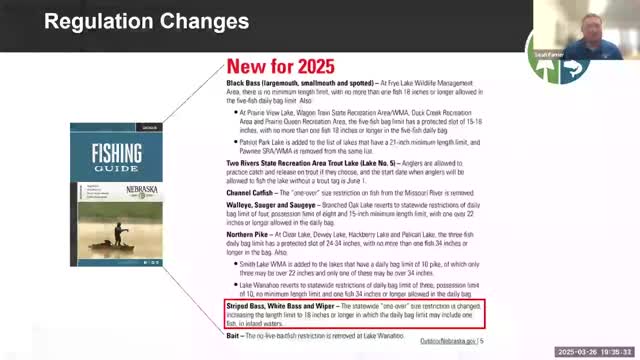Nebraska Game and Parks boosts McConaughey walleye population with new stocking strategy
May 23, 2025 | Nebraska Game and Parks Commission (NGPC), State Agencies, Organizations, Executive, Nebraska
This article was created by AI summarizing key points discussed. AI makes mistakes, so for full details and context, please refer to the video of the full meeting. Please report any errors so we can fix them. Report an error »

The Nebraska Game and Parks Commission (NGPC) held a significant meeting on May 23, 2025, focusing on the future of fisheries in the Southwest District. A key topic was the management of wiper populations in local reservoirs, where officials proposed raising the minimum size limit from 16 to 18 inches. This change aims to allow anglers more time to harvest these fish, preventing overpopulation and enhancing the opportunity for trophy-sized catches.
The meeting also highlighted the ongoing development of a new aquatic habitat plan, which is a 15-year working document designed to prioritize projects that improve local water bodies. Officials emphasized the importance of community input, encouraging residents and anglers to share their ideas and feedback on habitat improvements.
Stocking efforts were another focal point, with the NGPC reporting a substantial increase in fish stocking for 2025. The district plans to stock 32 million fish, with 24 million allocated to Lake McConaughey alone. This initiative is crucial for maintaining healthy fish populations and providing recreational opportunities for local anglers.
A notable update was provided on the walleye population at Lake McConaughey. Following concerns about an aging population and low recruitment rates, the NGPC has implemented a new stocking strategy that includes various developmental stages of walleye. Since 2022, nearly 71 million walleyes have been stocked, resulting in a promising increase in natural recruitment rates, which rose from 12% in 2022 to 22% in 2023.
The meeting concluded with a commitment to continue monitoring fish populations and stocking strategies, ensuring that the health of local fisheries remains a priority. As these initiatives unfold, they promise to enhance fishing experiences and support the local community's recreational needs.
The meeting also highlighted the ongoing development of a new aquatic habitat plan, which is a 15-year working document designed to prioritize projects that improve local water bodies. Officials emphasized the importance of community input, encouraging residents and anglers to share their ideas and feedback on habitat improvements.
Stocking efforts were another focal point, with the NGPC reporting a substantial increase in fish stocking for 2025. The district plans to stock 32 million fish, with 24 million allocated to Lake McConaughey alone. This initiative is crucial for maintaining healthy fish populations and providing recreational opportunities for local anglers.
A notable update was provided on the walleye population at Lake McConaughey. Following concerns about an aging population and low recruitment rates, the NGPC has implemented a new stocking strategy that includes various developmental stages of walleye. Since 2022, nearly 71 million walleyes have been stocked, resulting in a promising increase in natural recruitment rates, which rose from 12% in 2022 to 22% in 2023.
The meeting concluded with a commitment to continue monitoring fish populations and stocking strategies, ensuring that the health of local fisheries remains a priority. As these initiatives unfold, they promise to enhance fishing experiences and support the local community's recreational needs.
View full meeting
This article is based on a recent meeting—watch the full video and explore the complete transcript for deeper insights into the discussion.
View full meeting
